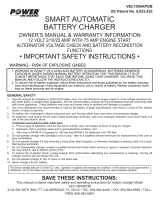
5
X Be aware that engine components e.g. the coolant fan
may start automatically. Keep hands and body away
from engine components and position the battery
charger and cables to prevent contact.
X Make sure that the battery charger and the cables are
located to prevent damage from closure of doors and
engine compartment covers.
X Make sure that the connections can be made without
touching the metal body or components adjacent to the
battery.
X When using this appliance in proximity to the vehicle's
battery and engine, stand the appliance on a flat, stable
surface and be sure to keep all clamps, cords, clothing
and body parts away from moving parts of the vehicle.
X If it is necessary to remove the battery from the vehicle
to charge or to clean the terminals, make sure that all
accessories in the vehicle are switched off, so as not to
cause a spark.
X To reduce the risk of electric shock, disconnect the
appliance from any power source before attempting
maintenance or cleaning. Turning off controls without
disconnecting the appliance will not reduce this risk.
Connecting the battery charger
When all the preparations for charging and personal safety
have been completed, proceed as follows:
X For most automotive and similar applications the battery
charger may be connected to the battery while it is
connected to the dc circuit. If this is acceptable follow
the instructions given in "Charging a battery installed in
the circuit".
X If the battery must be disconnected from the circuit
before charging, follow the instructions given in
"Charging a battery disconnected from the circuit".
Charging a battery installed in the circuit
Warning! An incorrect connection, a battery short circuit,
location of the battery and the location of the battery charger
may create a hazard. Make sure that adequate preparation
has been made before proceeding.
Warning! If the battery posts cannot be accessed or the
battery charger clamps will contact the bodywork or
components adjacent to the battery, the battery must be
removed before charging. Follow the manufacturer's
instructions to remove the battery.
X Check the polarity of the battery posts. A positive
(POS,P, +) battery post usually has a larger diameter
than the negative (NEG, N, -) battery post.
X Follow the manufacturers' instructions to remove any
insulating covers from the battery posts.
X Connect the positive (red) clamp from the battery
charger to the positive (POS, P, +) post of the battery.
X Connect the negative (-) black clamp to the chassis or a
solid non-moving metal vehicle component or body part.
Never clamp directly to the negative battery terminal or
a moving part. Refer to the automobiles owner’s
manual.
When disconnecting the battery charger from the battery,
always:
X Switch off and unplug the battery charger from the
mains supply.
X Remove the negative clamp first.
X Remove the positive clamp last.
X Refit any insulating covers to the battery posts.
Charging a battery disconnected from the circuit.
Warning! An incorrect connection, a battery short circuit,
location of the battery and the location of the battery charger
may create a hazard. Make sure that adequate preparation
has been made before proceeding.
If the battery is not already removed from the circuit, follow
the manufacturers' instructions to remove the battery before
charging.
X Check the polarity of the battery posts. A positive
(POS,P, +) battery post usually has a larger diameter
than the negative (NEG, N, -) battery post.
X Connect the positive (red) clamp from the battery
charger to the positive (POS, P, +) post of the battery.
X Connect the negative (black) clamp from the battery
charger to the negative (NEG, N, -) post of the battery.
When disconnecting the battery charger from the battery,
always:
X Switch off and unplug the battery charger from the
mains supply.
X Remove the negative clamp first.
X Remove the positive clamp last.
X Refit any insulating covers to the battery posts.
Features
1. Digital display, scrolling message
2. Language selection button
3. Function control knob
4. Battery clamps
5. LED status indicator
6. Charging gauge
7. Cable storage
8. Clamp storage
9. Carry handle
Language selection
The smart charger can display error message and
information in your chosen language. To alter the initial
language (default English), proceed as instructed below:













